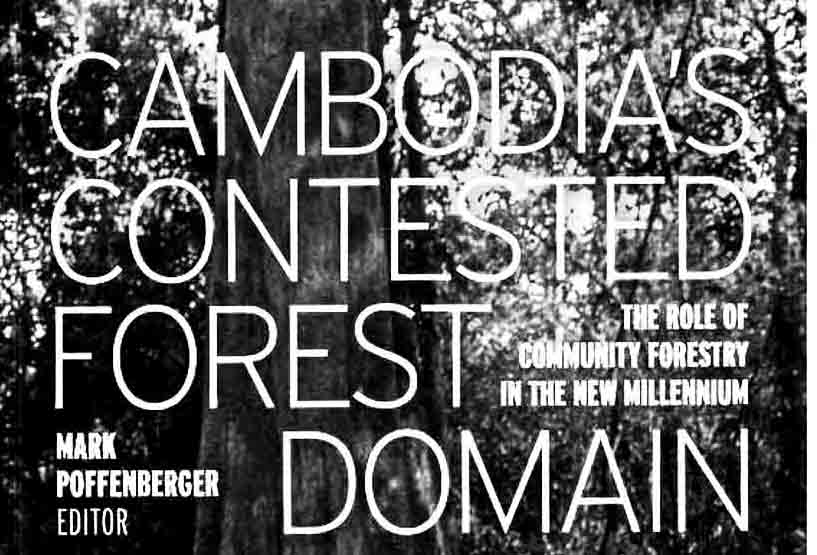Cambodia’s forests: to some a place of ‘sacred wild’; to others a source of timber and wildlife; to yet others an inconvenience, covering the soil they crave for the creation of a rubber or sugar plantation. Today, one cannot open a local newspaper without being confronted with yet another tale of forest clearing, land dispossession or wildlife poaching.
Cambodia’s forests stand at the frontline of the struggle over the country’s natural environments – how they are used, respected and managed – and the way that people and wildlife will be allowed to live and prosper within them now into the future. They are, if ever there was, a ‘contested’ zone.
It is into this conflict that a new book, Cambodia’s Contested Forest Domain, enters. Edited by Mark Poffenberger and with contributions from some of the foremost scholars on Cambodia’s natural environment (including Ian Baird, Jefferson Fox and Melissa Marschke), the book promises to provide some scholarly illumination on the challenges and opportunities facing Cambodia’s forests and the futures of those who depend on them. So how does it all stack up?
Firstly, the positive. By positioning itself in the interface of community – forest relations – thealigns itself neatly with a popular area of natural resource theory and practice. This, together with a set of authors who have honed their craft in this field of study, gives it both relevancy and depth.
Secondly, the detail provided in the editor’s introduction and the essays that follow will provide valuable information to anyone wishing to explore this field for themselves. In this capacity, Cambodia’s Contested Forest Domain provides a valuable starting point for others wishing to explore and comprehend local environmental issues further.
Thirdly, the publication’s essays draw on years of study from people who ‘know their stuff’. These are folk who’ve trekked through forests, slept on commune house balconies and been sucked on by leeches. They’ve done the hard yards and the depth and quality of research covered reflects this.
Now this is all fine and scholarly, but is it enough? Does the book deliver on the promise of its title? Here is where the problems start First up, by using the word ‘contest’ in its title the book gives the impression it’s going to embrace a particular approach in the studies that follow, one born of the exciting and emerging field of political ecology.
Now at this point, before you think, ‘What the hell is he talking about? I’m turning to the gig page,’ hold on! This little lesson could well be worth it. Political ecology explores the way the ‘meaning of things’ – forest, trees and animals, etc – are conferred and shaped through debates about their use and value. Behind this is the assertion that people respond to these ‘things’ based on the meanings and interpretations given to them by individuals and society.
However, because there are inevitably multiple interpretations of what forests are (‘sacred’, ‘home for wildlife’, ‘inconvenient land cover’), not all of these can be accommodated in the way they’re managed and exploited. This leads to ‘contests’, as different people and groups seek to have their interpretations take precedence over those of others. This competition is very important because, ultimately, the interpretation that becomes dominant, the one that ‘wins the contest’, will determine how a forest or other natural environment is exploited.
Lesson over! You can now see how the editor, by using the term ‘contest’ in the book’s title, creates an expectation that its respective authors will use these themes to explore the dynamics of forest conflicts in the Kingdom. That this subsequently fails to transpire, in any concerted and coordinated fashion, is my first disappointment. Let’s call it a case, perhaps unintentionally, of ‘false advertising’.
In comparison, the recent publication Beyond the Sacred Forest: Complicating Conservation in Southeast Asia does take on this opportunity and provides a series of excellent essays that grapple with the implications of political ecology for the region’s forests. Not the easiest read, it is still recommended here.
The second and arguably biggest concern is that, while the book features some of the most prominent ‘international’ scholars on Cambodia’s environmental issues, it includes only one Cambodian among its writers and not one voice from a forest community. This occurs despite the announcement in the editor’s introduction that: “The authors of this book take the position that one of the most promising approaches to restoring and conserving Cambodia’s forests… will be through the engagement of rural communities in their management.”
Apparently, such engagement does not extend to the inclusion of such communities’ words here. For an account that seeks to explore the role of local communities in the Kingdom’s forest debates, this seems a bit strange. Moreover it represents a lost opportunity, because there’s a range of excellent projects being undertaken here that seek to bring local voices into the forest debates underway. One only has to look at the outstanding documentary A River Changes Course, for example, to recognise the value of bringing these voices to the fore in debates about the Kingdom’s environmental conflicts.
It is also, of course, about respect.
This leaves me concerned that Cambodia’s Contested Forest Domain is perhaps the ultimate conceit: that it represents an effort by one group to assert their interpretations of Cambodia’s forest debates onto society, while minimising the voices and meanings of others. Perhaps I am just being too postmodern (or precious?), but it is by this measure, if nothing else, that the book disappoints.
Cambodia’s Contested Forest Domain: The Role of Community Forestry in the Millennium, edited by Mark Poffenberger, is available now from Monument Books for $13.
